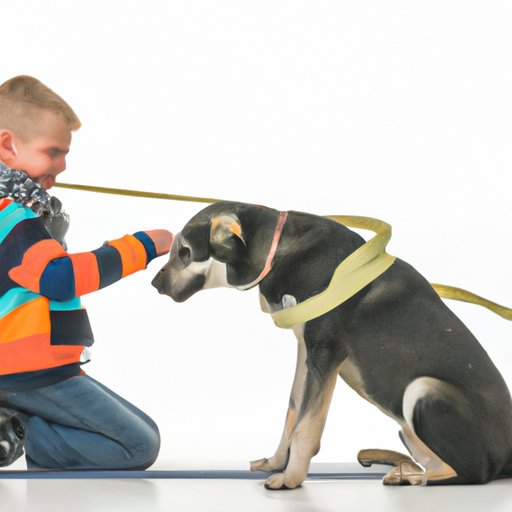Introduction
Service dogs are highly-trained animals that assist people with disabilities in carrying out daily tasks and leading independent lives. In this article, we will provide a step-by-step guide on how to train your dog to become a service dog, as well as discuss the benefits, legal requirements, and how to choose the right breed. We will also debunk common myths about service dogs and offer specific advice for training a service dog for children with disabilities.
A Step-by-Step Guide to Train Your Dog as A Service Dog
Before considering specialized training, it’s important to make sure your dog has basic obedience skills. Basic obedience includes commands such as sit, stay, come, heel, and down. Training your dog in basic obedience is essential for good service work because it helps your dog remain calm and attentive in distracting situations.
To train your dog as a service dog, follow these steps:
- Train basic obedience skills.
- Teach your dog the specific task(s) needed to assist with your disability.
- Train your dog in public situations with lots of distractions.
- Have your dog professionally trained by a certified service dog trainer.
It is important to keep in mind that training a service dog takes a great deal of patience, time, and effort, but it can be a very rewarding experience for both you and your dog.

The Benefits of Having a Service Dog
A service dog can help in many ways, including:
- Assisting with mobility and balance
- Retrieving dropped items
- Alerting to sounds or cues
- Providing emotional support
- Providing therapy for PTSD
Service dogs are not only helpful with physical tasks but can also provide a greater sense of independence and confidence to their owners.
For example, a service dog can help a person with a visual impairment navigate busy streets with ease or help a person with social anxiety disorder feel more at ease in public spaces. They can assist individuals with disabilities to live a more active and fulfilling life.
Understanding the Qualifications for a Service Dog
It is crucial to understand the legal requirements for a dog to be considered a service animal. The Americans with Disabilities Act outlines the criteria that must be met in order for a dog to be considered a service animal. They include:
- The dog must be individually trained to perform tasks for the benefit of an individual with a disability.
- The dog must be housebroken.
- The dog must be under the control of its handler at all times.
The ADA also stipulates that businesses and institutions may not require documentation or identification of a service dog before allowing them access.
It is important to know your rights and the rights of your service dog in order to navigate the world safely and confidently.
How to Choose the Right Dog for Service Work
When selecting a dog for service work, breed and temperament are important considerations. Breeds that are often used as service dogs include:
- Labrador Retrievers
- Golden Retrievers
- German Shepherds
- Poodles
- Bernese Mountain Dogs
It is important to select a breed that is not only physically capable of performing service work but also has a temperament that is friendly, social, and calm.
Common Myths About Service Dogs Debunked
There are several myths surrounding service dogs that we will debunk:
- Myth: Only certain breeds can be service dogs.
- Fact: Any breed can be trained to be a service dog as long as they have the physical ability and temperament necessary.
- Myth: Service dogs are never allowed to be petted.
- Fact: While service dogs are working, they should not be distracted or petted. However, if the handler allows it, service dogs can be petted when they are not working.
- Myth: Service dogs wear vests to identify themselves as service dogs.
- Fact: Service dogs are legally not required to wear identifying vests or gear. However, some handlers choose to use them as an additional visual cue to help others identify their dog as a service dog.
How to Keep Your Service Dog Safe and Healthy
Caring for a service dog requires proper grooming, nutrition, exercise, and veterinary care. Here are some tips:
- Regularly brush your dog’s coat to keep it healthy and avoid matting.
- Feed your dog high-quality food appropriate for their age and breed.
- Provide your dog with regular exercise to keep them fit.
- Take your dog to regular veterinary checkups for preventative care.
Advice for Training a Service Dog for Children with Disabilities
When training a service dog for a child with a disability, it is important to make sure that the dog is well-suited for the child’s specific needs. Here are some additional tips:
- Involve the child in the training process as much as possible.
- Include the child’s therapist or medical provider in the training process.
- Teach the dog to respond to the child’s specific needs, such as alerting to seizures or helping them balance while walking.
Conclusion
Training a dog to become a service dog can be a rewarding experience that ultimately benefits the handler and the dog. It is important to understand the legal requirements, choose the right breed and temperament, and be patient and consistent while training. By following these steps, you can successfully train your dog to become a valuable and supportive service animal.
